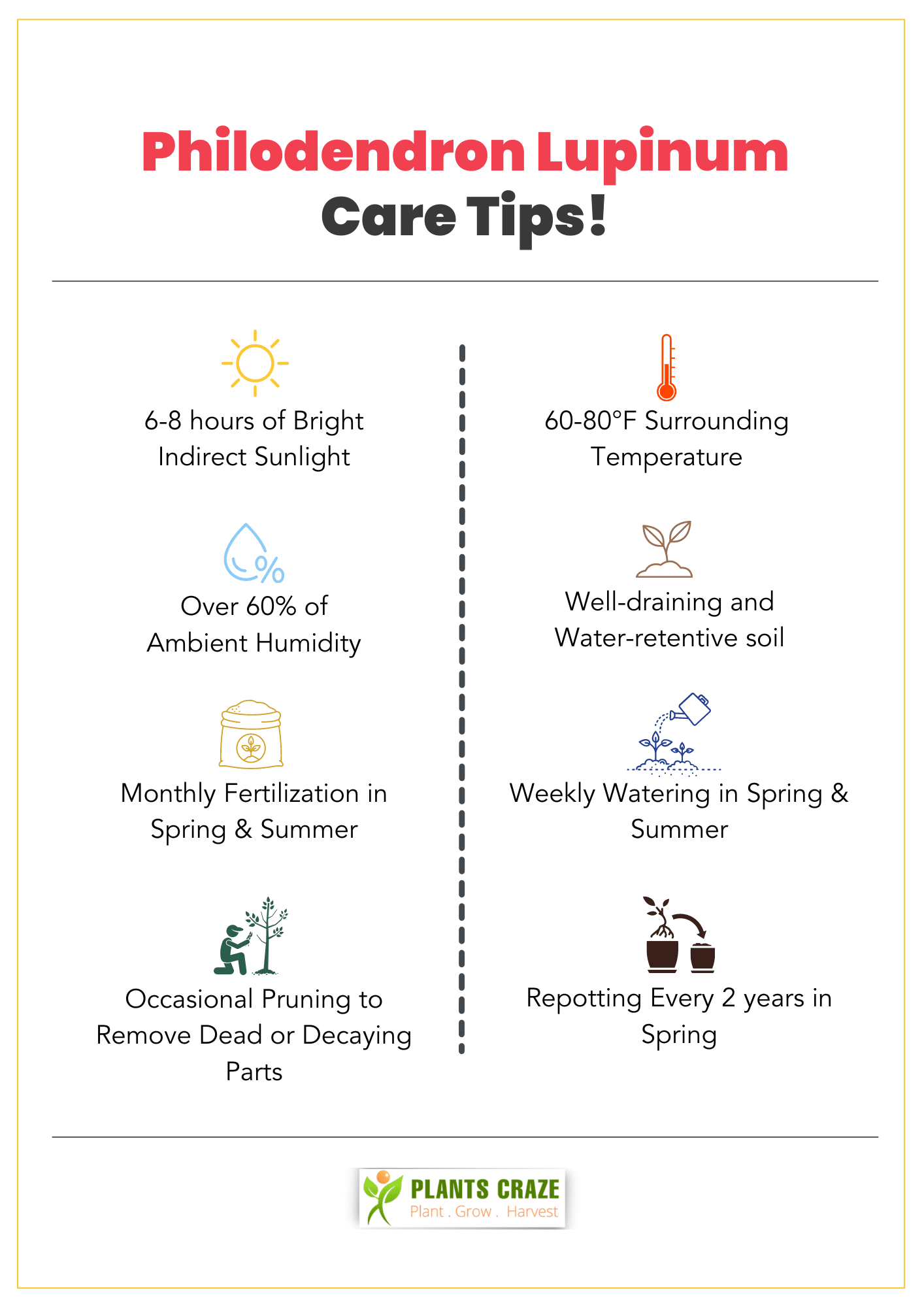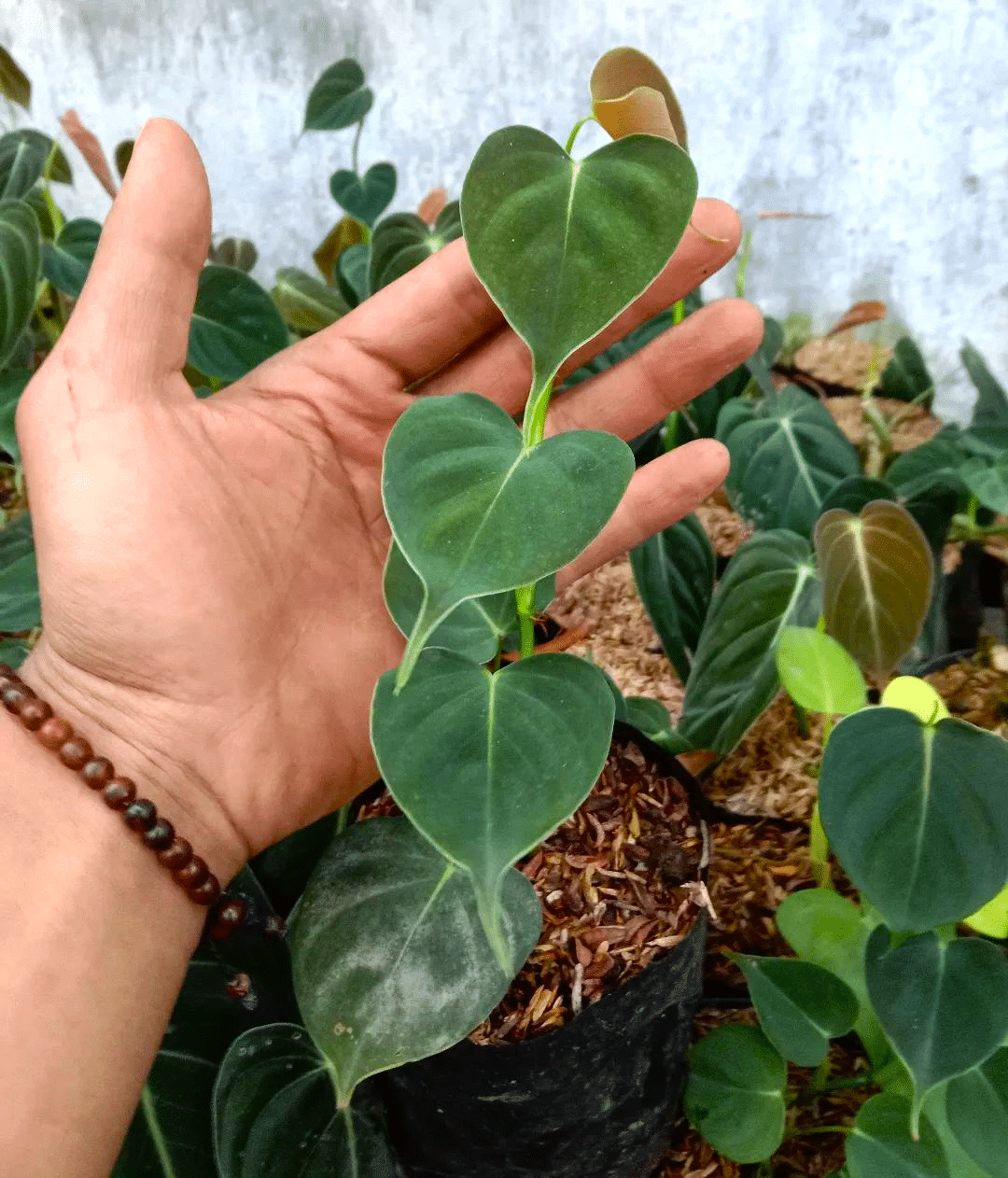Many gardeners take the easygoing nature of Philodendron lupinum for granted and face issues like leaf discoloration and root rots.
But that is not enough to keep them upbeat. So, read on till the end to learn tips and tricks to keep Lupinum happy and thriving for more.
Table of Contents Show
Philodendron Lupinum Overview
The Araceae family encompasses Philodendron lupinum, indigenous to Brazil.
Lupinum word is derived from the Latin term ‘Lupinum,’ which means ‘wolf’ and refers to the pinnate leaf blade that resembles a wolf’s head.
| Indicator | Identity |
|---|---|
| Common name | Lupinum Corrugated Leaf |
| Origin | Brazil |
| Family | Araceae Juss. |
| Genus | Philodendron Schott |
| Species | Philodendron Lupinum |
| USDA zones | Zone 9 to 11 |
| Plant Type | Climbing hemiepiphyte |
| Growth Habit | Can reach up to 10–20 ft (3–6 m) |
| Foliage | Glossy Foliage Can become a massive foliage up to 10 to 12 inches on maturity. |
| Flower | Deep red, aromatic spathes up to 15 cm (6 in) long Blooming Season: Summer and autumn |
| Toxicity | Toxic to both humans and animals |
Philodendron Lupinum: Expert Guide
Even with minimal maintenance, this tropical plant thrives in your space. You can grow them as an outdoor plant or a houseplant in warmer areas.
Here’s a quick care hack at what your Philodendron lupinum plant loves and loathes!

Now, let us delve deeper into the elaborated primary care factors, shall we?
1. Sunlight & Temperature
Lupinum flourishes in the medium bright light of intensity 2,500 to 10,000 lux and temperature of 60-80°F.
But, protect them from direct sunlight as it results in leaf discoloration due to rapid transpiration brought on by excess heat.
On the contrary, low light and temperature below 55°F push back the growth and causes leaves to turn yellow, curl, droop and wilt.
Within USDA 9 to 11 zones, you can grow Lupinum outdoors under partial shade. But in colder zones, move them indoors in winter.
You can use heat pads, frost blankets and pine straws to trap heat and keep your plants warm.
Meanwhile, aim to use suitable grow lights for Philodendron’s growth for about 8 to 10 hours.
2. Water & Humidity
Philodendron lupinum requires moist but not damp soil aided with moderately higher humidity (>60%) to thrive.
Besides that, allow topsoil to become slightly dry between the watering schedule in all seasons.
Meanwhile, fetch them water via the bottom watering approach and place pebbles on the water saucer to avoid watering issues.
Generally, excess water or humidity triggers root rot and leaf discoloration resulting in yellow leaves.
However, low moisture content causes the plant to droop, wilt and turn brown or yellow.
3. Soil & Fertilizer
Philodendron lupinum thrives on porous, well-draining soil (pH 6.5 to 7) abundant in organic compounds.
Alternatively, opt for commercial mixes like Philodendron, Premium Aroid Mix, and Miracle-Gro Mix.
Remember, Lupinum barely takes up nutrients in winter, so refrain from fertilizing to avoid issues like salt build-ups and chemical burns.
Besides that, ensure the fertilizer contains all nutrients and dilute them before application.
Pro Tip: Water your plant before adding the fertilizer. To avoid burns and root damage, nutrients should be administered to damp soil.
4. Potting and Repotting
Grow a Philodendron lupinum in a slightly bigger pot than its root ball, ensuring the pot has plenty of drainage holes.
Rootbound Lupinum exhibits signs of poking roots from drain holes, stunted growth and sudden leaf drop.
Furthermore, repotting Lupinum is inevitable when infected by bacterial leaf spots and blight.
In such peril, prune the infected leaves, thoroughly apply bactericide and then repot the plant in a sterilized pot.
Otherwise, late spring or early summer is the ideal time of the year to repot Philodendron lupinum.
5. Occasional Pruning
Like any other Philodendron, Lupinum is no different when it comes to pruning care.
They do not demand regular pruning but enjoy occasional pruning of diseased, damaged, overgrown or lanky leaves.

You can give them a mild haircut any time of the year except for winter to keep them in the desired shape.
However, urgent pruning is essential when pests like aphids, scales and mealybugs ravage the plant.
Carefully prune off the damaged parts and apply insecticides to control further spread.
You can prevent such dire conditions by regularly applying neem oil and incorporating ideal watering and humidity routine.
Philodendron Lupinum: All About Growth
Philodendron lupinum is a hemiepiphyte climber known to shapeshift with progressive aging.
With a glossy wavy pattern, the underside remains vermilion to reflect light toward the top cells involved in photosynthesis.
Despite the slow growth rate, mature Philodendron lupinum can have over 10 to 20 feet long vines.
Interestingly, Philodendron lupinum’s crawl capacity is a purposeful modification for extending out for light.
You can stake the Lupinum using a sphagnum moss stake or pole to facilitate its climbing skills.
Besides that, Philodendron lupinum also produces deep red, aromatic blossoms with six-inch long spathes in summer and autumn.
Philodendron Lupinum Toxicity
Like other aroids, Philodendron lupinum is also not a safe plant to have around pets and childrens.
While it might not be life-threatening in humans, pets might gravely suffer if they consume the plant in large amounts.
Some common signs of poisoning include oral irritation, hypersalivation, loss of appetite, vomiting and upset stomach.
Therefore, it is advised to keep all Philodendron species away from pets’ and kids’ reach to avoid accidental consumption.
Here are a few helplines you can rely on if you notice any signs of Philodendron poisoning.
- Pet Poison Helpline: 855-764-7661
- ASPCA Poison Center: (800) 426-4435
Propagation of Philodendron Lupinum
You can easily populate the aesthetic Philodendron lupinum via stem, seeds and air-layering.
However, most gardeners prefer to propagate Lupinum via stem cutting as it is easier with simple, efficient steps.
1. Stem Propagation
Stem clippings are the most convenient technique to proliferate Lupinum as they easily adapt to the soil and take a relatively shorter time for new growth.
- Find a healthy stem with a leaf node attached and make a clear cut right below the leaf node using a sterilized pruner.
- Remove the foliage at the bottom to uncover the nodes but leave at least one top leaf intact.
- Place the clippings in a clear jar of rooting hormone and water.

- Otherwise, cover the nodes in moist sphagnum moss.
- Regularly mist using a spray bottle to keep the clipping moist.
Within a month, you should be able to notice new root sprouting from the cuttings. Once they have grown over an inch, consider transplanting them into a new pot.
2. Seeds Germination
Although time-consuming with a lower success rate, Lupinum can be grown from seeds.
To ensure optimal chances of proper germination, aim for fresh or recently harvested Philodendron seeds.
- Presoak the seeds for 24 hours in lukewarm water.
- Sow the seeds about a third of an inch deep in fresh starter mix.
- Regularly mist the tray to keep the soil moist but not soggy.
- Cover the seed tray with clear plastic to mimic a mini greenhouse.
- Also, poke some holes in the plastic to allow fresh air circulation.
- Maintain the temperature at a relatively warmer level (68-73°F) for optimal germination.
Within 2 to 8 weeks, the Philodendron seeds should sprout. Once they have firm, legit sturdy roots, aim to transplant them.
After the transplant, proceed with the regular Philodendron Lupinum care routine.
3. Air Layering Method
Relatively sophisticated but air layering method is another way of Lupinum propagation.
- At a 45-degree angle, cut midway through a healthy stem of Philodendron lupinum.
- Use a small piece of plastic and place it over the puncture.
- Applying plastic wrap and rope, tie some moss around the sliced part of the plant before connecting the moss to the stalk.
- In around two weeks, roots will emerge on the moss.
- You can detach the baby plant from the incision location after observing a sound root system forming on the moss.
- Place the plant in a new container with its moss.
- Ensure the planter is big enough for healthy root development with proper drainage.
Where to Buy Philodendron Lupinum?
Philodendron lupinum was firstly discovered in 2008, so they are relatively rare and hard-to-find houseplants.
However, I have scoured the internet and found some verified retailers with Philodendron lupinum for sale.
| Shops | Expected Shipping Time |
|---|---|
| Etsy | 1-2 business days |
| Gabriella Plants | Within 7 days |
| My Home Nature | Within 10-15 business days |
| Happy Forest | Within a week |
Final Thoughts!
Philodendron lupinum is an excellent first-time houseplant for anyone who wishes to appreciate the unique plant features without worrying about upkeep.
Remember to adjust your watering routine in accordance with light exposure, temperature, season and fertilization.
All The Best!


